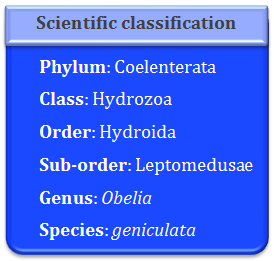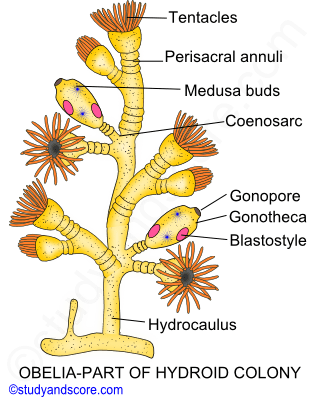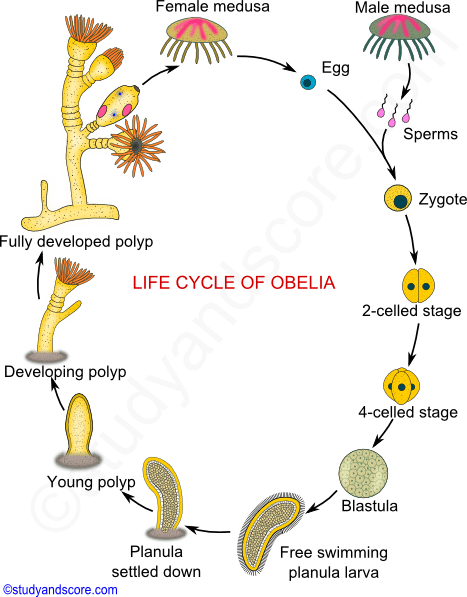
It is cosmopolitan in distribution in other words, worldwide distribution except the high-arctic and Antarctic seas. The medusa stage of Obelia species is common in coastal and offshore plankton around the world.
Obelia is sedentary, marine and colonial form. It is found up to the depth of 80 meters. It occurs in both asexual and sexual forms. It grows in intertidal rock pools and at the extreme low water of spring tides.
Obelia is also called as Sea fur. The hydroid colony of Obelia is delicate, semitransparent and whitish to light brown in color. It consists of vertical branching stems are called as hydrocauli and the root like branches are called hydrorhiza. Both are of same thickness. The growth of the colony is sympodial.
Each of the vertical stem or hydrocauli branches in an alternate manner. The ultimate branch terminates in a nutritive zooid called polyp or hydranth. In the older polyps cylindrical reproductive zooids are placed which is known as blastostyle or gonangia. This Obelia colony is dimorphic exhibiting two types of zooids. When the blastostyles develop saucer-shaped bodies called as medusae, the dimorphic colony becomes trimorphic. The following are the three zooids of the Obelia colony,
Polyp or hydranth (nutritive zooids): This nutritive zooid of the colony is also known as gastrozooids or trophozooid. It is yellow in color, radial symmetrical and cylindrical in shape. They are specialized for capture, ingestion and digestion of food. Each hydranth is closely similar in structure to that of hydra. It has a sac-like body. The basal end is not closed but connected by a hollow stalk with the hydrocaulus. The body wall composed of ectoderm, mesogloea, and endoderm encloses a simple enteron that opens to outside by the mouth situated at the free end of the hydranth. Mouth is situated at the apex of the hypostome. The ectoderm of the hydranth is thin. The nematocysts are present only on the tentacles. The middle structure less layer, the mesogloea, has nerve net present on its both sides.
The endoderm cells are similar to those of hydra. The nutritive-muscular cells possess flagella at their inner ends. The gland cells are large and with granular inclusions. The tubular perisarc surrounding the coenosarc extends around the hydranth to form its conical protective covering known as hydrotheca.
Blastostyle (reproductive zooids): After the hydrocaulus has reached its full development it gives rise to special zooids called blastostyles. They are fewer in number as compared to hydranths in the colony.
The mouth and tentacles are absent in these simplified zooids. They cannot feed hence their enteron is reduced in size. The distal closed end usually forms a flattened disc. The perisarc extends over the blastostyle to form a cylindrical or vase-like transparent gonotheca.
The blastostyles are the reproductive zooids as they reproduce asexually to give rise to numerous lateral buds called medusa buds or gonophores. These buds develop into third type of zooids of the colony called medusae. When they are fully formed they are set free and swim away from the colony by escaping through the ruptured distal end or by opening of the lid of the gonotheca.

Medusae: These are small, transparent, solitary, free swimming saucer-shaped or bell-shaped zooids. They measure about 6 mm in diameter. These are the reproductive zooids which produce the sex cells.
The inner concave side of the body is known as sub-umbrella and outer convex as exumbrella. A short, hollow, quadrangular projection, the manubrium, hangs down from the middle of the sub umbrella surface. This structure together with the disc or bell-shaped body of the medusa gives it an umbrella-like appearance. The mouth, a square or four sided opening is situated at the tip of the manubrium.
The mouth leads through the cavity of the manubrium into a small gastral cavity or enteric cavity or stomach situated in the central part of the main body of the medusa. From this cavity radiate four narrow radial canals situated at equal distances from each other. These canals run outwards toward the edge of the umbrella and open into a circular canal running around the edge of the umbrella. This system of canal enables the food to be taken in at the mouth and manubrium and digested in the stomach to be distributed through them to the entire medusa.
The edge of the medusa gives off on its inner side a very narrow, rudimentary fold or shelf called the velum. The margin of the umbrella gives off short tentacles which are sixteen in number in the newly born medusa but are numerous in the adult. Ectoderm covers both the surface of the umbrella and the outer surface of the manubrium. The endoderm lines the cavity of the manubrium, ‘stomach’, radial canals and circular canals which together represent the enteron. Endoderm does not extend into the velum.
The primary function of the medusa is sexual reproduction. Obelia is dioecious as each medusa has reproductive organs of only one sex. There is no difference between the male and female medusae. The gonads (testis or ovaries) are four in number and lie on the sub-umbrella, below the radial canals, in the form of knobs. Thus gonads are per-radial in position. They are situated almost at equal distances between the manubrium and the velum. The gonads which arise as diverticula of the radial canals have the same structure as the body wall of medusa. The sex cells start developing very early when the medusa is being formed. These cells originate in the ectoderm of the manubrium, migrate to the endoderm and finally make their way to the gonads. They lie between the ectoderm of the sub-umbrella and the mesogloea.

Fertilization: The sperm and ova when fully formed are set free in water by rupture of the outer wall of the gonad. Sometimes the flagellated sperms swim about in water and fertilize the ova present in female medusae. The fertilization takes place in water. As medusa is the motile form, it performs two important functions for the colony namely reproduction and dispersal of the gametes.
Cleavage: The fertilized egg undergoes cleavage which is equal and holoblastic (complete). The blastula is a hollow boll consisting of single layer of cells enclosing the blastocoel. This cavity gets completely filled up with cells budded from the wall of the blastula. The embryo is now called stereo gastrula or solid gastrula. The embryo is set free from the egg membrane as a free-swimming larva called the planula. The larva swims about for some time and brings about wide distribution of the species. A cavity soon appears in the endoderm cell mass, which becomes the enteron.
Hydrula: After the free-swimming life the planula larva loses its cilia and settles down on the bottom of the sea, gets attached to the substratum by its broader end and undergoes metamorphosis. The attached or proximal end widens into a disc of attachment. A short distance from the free or proximal end a dilatation is formed. From this portion tentacles arise in a circle as short buds. The narrow portion beyond their origin becomes the hypostome. Soon an aperture, the mouth, is formed at the end of the hypostome. The young hydranth closely resembles a simple polyp like hydra and is called hydrula which undergoes repeated asexual budding to gives rise to complex Obelia colony.
Alternation of generation: Alternation of generation is also known as metagenesis. It is a phenomenon whereby, in the life history of an organism, a diploid asexual phase and a haploid sexual phase regularly alternate with each other.
In Cnidaria, two types of individuals exist namely a polyp and a medusa,
Polyp: The tube like zooid is called polyp. The polyp reproduces asexually It is sessile and attaches to a substrate at the aboral end. It has a cylindrical body called the column. Its mouth is surrounded by food-gathering tentacles.
The body structure of polyp form is simple with simple muscles and nervous system. Velum is absent. Mouth is circular without oral lobes. Also its gastro vascular cavity is simple without radial circular canals. Sensory organs are absent in this form. This form reproduces asexually by budding.
Medusa: The umbrella like zooid is called medusa. The medusa is dioecious and free swimming. Its shape is like an inverted bowl. The tentacles hang from its margins. The mouth opening is centrally located at lower side. The medusa swims by medusa than in a polyp. It gives the medusa a jellylike appearance.
The body structure of medusa form is complicated with well-developed muscles and nervous system. Velum is present around the margins of the umbrella shaped body. Also its gastro vascular cavity is well-developed with radial and circular canals. Sensory organs called as statocysts are present on the margins of the tentacles. These forms reproduce sexually through gametes.
These two forms, polyp and medusa alternate successively where the polyp reproduce asexually to form a large number of medusa, each medusa reproduce sexually by the union of eggs and sperms to form zygote. The zygote grows into larva, which fix itself to a substrate and finally form a new polyp.

- Share with your friends! -
Login to post your comment here...
- or with social Account -